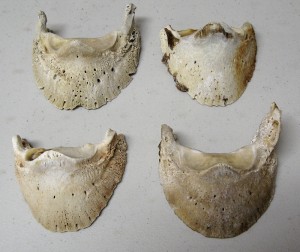The coffin bone, also known as the pedal bone or the third phalanx is totally enclosed in the hoof capsule and is what what controls the shape of a horse’s hoof. In horses that have a short wide coffin bone, such as the one in the upper left in the photo will have a foot that is wide and short, which is quite common in Thoroughbreds. Other horses will have coffin bones that are long and narrow, such as the one on the upper right, giving a lon narrow foot. Also note that the coffin bone has a number of holes in the surface. This is where blood vessels are located in the bone and it is through these vessels that the laminae are nourished. The bottom of the coffin bone is convex and the sole of the foot follows this shape to form the bottom of the foot. The coffin bone is articulated with both the navicular bone and the short pastern bone. This is in the form of a hinge joint that allows the foot to bend back and forth, but has little side to side movement. At the back of the coffin bone are the wings of the coffin bone. These are attached to the lateral cartilages, and in some cases the lateral cartilage will change to bone (ossify) and create what is known as sidebone. This can be seen on the right side of the coffin bone on the bottom right. The point at the top of the coffin bone is the attachment point for the digital extensor tendon, and the deep digital flexor tendon inserts on the bottom of the coffin bone along what is called the semi-lunar crest.
Farrier Service Plus
Whole Horse Farriery by Ward Edwards

